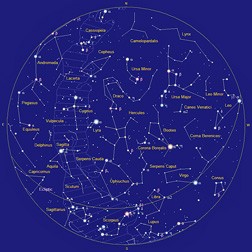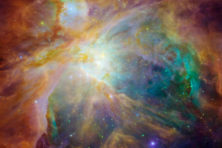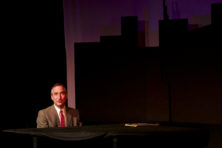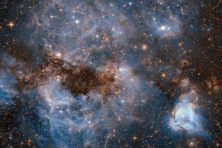Night Sky Highlighted During Universe in the Park
- Share
- Tweet
- Pin
- Share

This map portrays the sky as seen near 40° north latitude at 11 pm in early July. Map courtesy of nightskyinfo.com.
Graduate students from the University of Wisconsin – Madison will be visiting several state parks in Door County this summer and early fall to present Universe in the Park sessions, an outreach program of the school’s Astronomy Department.
“We’ve been running Universe in the Park for 14 years. The program is based on the simple idea that the best environment in which to introduce the general public to astronomy is outside under the dark skies we find in Wisconsin state parks,” said Professor Eric M. Wilcots, who directs the National Science Foundation-funded program.
“We will begin the evening with a presentation on some aspect of astronomy and recent news and discoveries from the astronomical community,” Wilcots said. “There will be plenty of opportunities for people to ask questions. Following the presentation, the visitors/campers will be invited to look through one of our Universe in the Park telescopes and see the wonders of the summer sky.”
He said those in attendance can look forward to seeing Venus, Saturn, the Moon and other deep sky objects.
Wilcots said a typical session begins just after sunset with a 20- to 30-minute talk and slide show about astronomy.
After the presentation, two moderate aperture (8″-10″) telescopes are set up to view whatever astronomical objects are available.
The first session will be held Friday, July 12, at Newport State Park.
“Since Newport is a wilderness park we have very little interference with outdoor lighting so we like to say that we are the darkest park on the peninsula and with 11 miles of undeveloped lake Michigan shoreline, Newport provides a great eastern sky view beginning at the horizon,” said Park Naturalist Julie Hein Frank, who added that the program returns in August and October for two different meteor showers.
“They will also be coming to Newport on Aug. 12 for the Perseids meteor showers and on Oct. 5 for the potential sighting of the Draconids meteor shower, and that night there will be a new moon, which will provide an even darker sky,” she said.
This month the Universe in the Parks program works its way south from Newport State Park on July 12 to Peninsula State Park on July 13 and Potowatami State Park on July 14.
The program returns to Newport for the annual Perseid meteor shower on Aug. 12.
The Perseid meteor shower is actually the debris from a comet known as Swift-Tuttle, named for American astronomers Lewis Swift and Horace Tuttle, who identified the comet in July 1862. Every year, from about mid-July to late August, Earth passes through the comet’s debris trail. The pieces from Comet Swift-Tuttle slam into the Earth’s upper atmosphere at 130,000 miles per hour, causing the annual late-night light show.
This year astronomers are saying that the nights of Aug. 11 – 13 are the best for viewing.
The Universe in the Park program returns to Door County in early October for the Draconid meteor show, so called because the meteors appear to radiate from the constellation Draco the Dragon. A Universe in the Park session will be held at Peninsula State Park on Oct. 4 and on Oct. 5 at Newport State Park.
Attendees are advised to bring blankets or lawn chairs to any of the night sky viewing events.
For more details on the Universe in the Park program, visit astro.wisc.edu/uitp.
For individual park information visit dnr.wi.gov/topic/parks/name/newport, dnr.wi.gov/topic/parks/name/peninsula, dnr.wi.gov/topic/parks/name/potawatomi.




